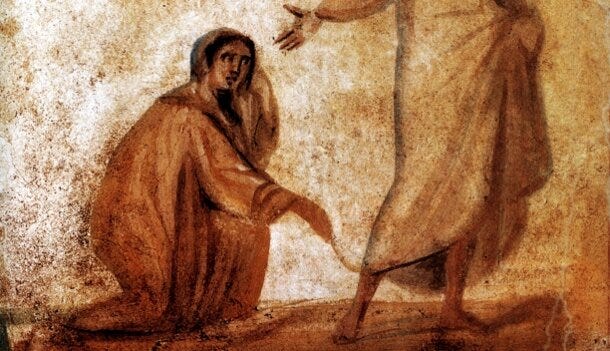Dear Friends,
I’m assuming many of you are deep in General Convention social media this week. Or maybe you’re sighing over the drama of the new ACNA Archbishop. Some of you might have finally decompressed following the Methodist’s General Conference and are glad it’s someone else’s turn to deal with ecclesial goings on. Or maybe you’re lucky enough to have a less… intense relationship to denominational polity.
I, unfortunately, belong to a social circle that has no chill about these things. My boss was smart to leave the country during GC, I think!
Still, I pray for that gathering – in all its complications. As this Sunday’s Psalm begins,
Out of the depths have I called to you, O Lord;
Lord, hear my voice; *
let your ears consider well the voice of my supplication. (Psalm 130:1)
Who Is Healed?
The other day, in one of the many formation Facebook groups I spend my time in, someone asked what the group felt was the most important thing for children to know about healing prayer. As long-time readers know, I have a lot of feelings about the idea of healing – or, more accurately, about cure. It’s a fine distinction, one that my mentor and the Canon for Intergenerational Formation at St. Mark’s Cathedral in Seattle captured on the post, noting that “[w]henever we offer healing prayer, [the Dean of the Cathedral] is careful to note that healing is not curing. Healing is about being restored to God.”
This Sunday’s Gospel includes two healing narratives – both the hemorrhaging woman who touches the hem of Jesus’s cloak and Jairus’s daughter, who is understood by her parents to be dead. Both are very much painted as healings enabled by faith. But in thinking about these stories alongside the above question about healing prayer, I found myself wondering how we get at the distinction between cure and healing in a way that would resonate with young children – and I thought about one of my favorite kitschy Christian products:

Yes, those really are Jesus Heals bandaids. Personally, I think every church school first aid kit needs some.
But the idea of healing and of these bandaids left me thinking about the way young children ask for bandaids constantly (check out the photos for the rest of the bandaid listing – it’s got some peak “child covered in bandaids” images) not because they have an actual injury that needs protection, but because it is part of reassurance and restoring a sense of security. It’s not unlike asking a parent to kiss a bumped knee or elbow to make it better – the kiss and the bandaid heal the anxiety from falling, the sense of being startled, the feeling that something has gone wrong, even though they don’t do anything for a physical injury.
Even though bleeding scrape from tumbling off a scooter benefits from being covered by a clean bandaid, it is the tenderness, the reassurance that comes along with its application that makes the bigger difference. That moment resolves the injury, not the many days of waiting for the cut to scab and slowly fade.
Our closeness to God heals. Curing is another matter that rarely matters as much, even in the case of serious illness and injury. When so much is on the line, we still find much of our redemption in relationship.
Perhaps instead of thinking about the language of healing as being closest to curing or fixing, we might think of it along the lines of safety or nurturance. I wonder, who or what makes you feel safe?
I wonder, have you ever felt God near you when you were sick or scared? How did that make you feel? What was it like?
Kayla Craig’s Prayer for a Child with a Disability does beautiful work of seeking healing in a world bound to the logic of cure. We are made in God’s image, and we are intimately known, and that is what allows for our healing.
Resource Round-Up
What’s new this week?
My website has gotten some solid updates! Drop by to learn more about scheduling access & inclusion training for church school volunteers, neurodiversity-focused ministry coaching, and more. (I’ve still got some updates to make to create libraries of my favorite resources – one thing at a time!)
Sock Religious released a new window cling set that encourages children to play with the components of the altar. I love resources like this for home, the prayground, pew busy books, and classroom response materials. (They also make Nativity and Empty Tomb sets.)
Have you used The Way of Love in formation in your community? Maybe you’ve even used it with kids. Well now Forward Movement has a new resource, The BIG Way of Love for Kids – redesigned as playing cards with activities. The activities are scaled by age and color-coded by the different aspects of the Way of Love. Plus, at $10, it’s a super affordable resource for home or parish. And, of course, it pairs perfectly with Roger Hutchison’s The Very Best Day.
If you’re a fan of the classic Common Prayer for Children & Families, it’s now got a supplement, Prayers for Every Season.
I met the artist Mollie Donihe almost three years ago now at my first Wild Goose Festival, and I was so taken by her art – she’s an extraordinarily talented textile artists. But while business-wise, Mollie is on a bit of a maternity leave right now, she wrote this beautiful prayer/essay for her newborn son a few weeks ago. It’s worth sitting with this piece of writing, and obviously worth subscribing to her newsletter.
That’s all for this week. I’m mid-Church School closet cleanout, so pray for me amidst the dust and theologically questionable craft projects.
Peace,
Bird




